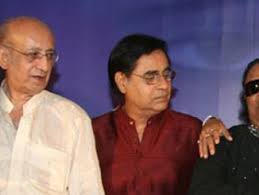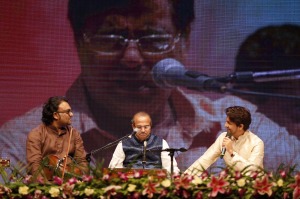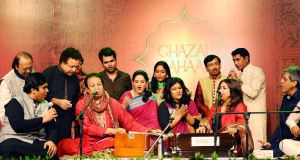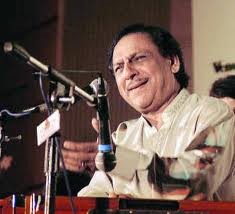
Today, October 7 2014, is the birth centenary of ghazal empress Begum Akhtar. A tribute
Woh jo hum mein tum mein qaraar tha, tumhe yaad ho ke na yaad ho
Wohi yaani vaada nibaah ka, tumhe yaad ho ke na yaad ho
THE year was 1986, and it was the first time I was hearing, or rather overhearing, the divine voice of Begum Akhtar. I was 22 plus, and till then, I had been exposed to ghazals in a limited manner, mainly through the songs of Jagjit-Chitra Singh, Ghulam Ali, Rajendra-Nina Mehta, Pankaj Udhas and Talat Aziz. I had heard only a few songs of Mehdi Hassan, and my tastes were more inclined towards rock bands like Jethro Tull, Pink Floyd and the Moody Blues.
Abhay Kant, a journalist colleague who stayed in the neighbouring room in Jaipur, was obsessed with Begum Akhtar, and would play her songs late into the night. I barely paid attention, and at times, even got irritated with him. But once, after ending a round of Pink Floyd, I caught a few strains of ‘Woh jo hum mein tum mein’ playing through his window. The curiosity increased, and after a few days, whenever the ghazal queen played next door, I would ensure that the rock fraternity didn’t disturb her.
A few days later, I sat with Abhay for a Begum Akhtar session, and he patiently, but unsuccessfully, tried to explain the meanings of the difficult Urdu words that regularly came up. The songs that made some sense included ‘Ab chalakte hue saagar dekhe nahin jaate’, ‘Ae mohabbat tere anjaam pe rona aaya’, ‘Deewana banana hai toh to deewana bana de’ and ‘Dil ho to hai na sang-o-kisht’. He tried to explain the style of the poets, but at that time, I was never too interested, showing some expression only when the name ‘Ghalib’ was mentioned. He seemed to be in fashion, after all.
Abhay had seven or eight ghazals in his collection, and as long as he stayed there, I received an occasional dose of Begum Akhtar. He suddenly left for a job in Delhi or Patna, and for another four years, I did not hear that golden voice. When I relocated to Mumbai in late 1990, I picked up two cassettes from Rhythm House, just to give them a shot. That was when the craze actually began. Over the years, the two ghazal singers who’ve had the major impact on me are Mehdi Hassan and Begum Akhtar.
—
FOR the true appreciation of ghazals, a few things are required. The first aspect involves the basic composition. After all, a ghazal with a melodious and distinct tune is more likely to create an impact. For the listeners, additional knowledge of classical raags and taals will help, though in this genre, one may argue that it may not be as necessary as it is with Hindustani classical or Carnatic music. Since the ghazal is a lighter form, a catchy tune can instantly attract the listener, whether or not he can identify the raag.
Secondly, and more important, one needs to have a basic understanding of the Urdu language, or at least the desire to comprehend the words used. Since many poets, mostly the classical ones, tend to use complex phrases, one may need to keep referring to a dictionary or the Internet. But without understanding the true meaning of the words, one can never get the exact gist of the ghazal. In a related sense, it is important to know the mood of the piece, whether it is romantic or political or emotional or even satirical.
Next comes the technicalities of writing. One must be able to distinguish between a ghazal, which uses rhyming couplets, a nazm, which uses free poetry, and a geet, which is more of a simple song. One should be able to identify a qataa (which has two shers) and a rubaai (which uses a four-line format). One should be able to define the matla (the opening couplet), the makta (the last couplet), the behr (metre) and takhallus (the writer’s pen name, often used in the makta). Equally important, one should understand portions known as kaafiya and radeef, which are used for rhyming, and other forms of writing jargon like misra-e-oola (first line of a couplet) and misra-e-saani (second line).
While these terms may sound too highbrow to the lay listener, the fact is that they are actually very simple to understand and are essential to enhance true appreciation.
Finally, the singer’s own style plays a supreme role. The texture of their voice and the soulfulness with which they express words distinguish them from the others. Though one hears the singer’s voice first, normally before one gets into the verbal depths, the truth is that only a great voice will make you want to come back to the song, irrespective of how deep its meaning is.
The choice of poetry, the uniqueness of the composition and the singer’s manner of expression all combine to increase the beauty of the ghazal. And this is where Begum Akhtar displayed her own style. Her voice brimmed with pathos, the musical compositions and arrangements set the right mood and the words were powerful enough to leave a lasting impact. And it wasn’t only in ghazals that she was the master – her rendition of light classical thumris and dadras (like ‘Ab ke saawan ghar aaja’, ‘Koyaliya mat kar pukaar’ and ‘Hamri atariya’) was exquisite too.
—
LET’S now specifically look at Begum Akhtar’s choice of poetry. If one examines her repertoire, one notices two things. One is that she has sung the work of most of the top-notch poets extensively. The second is that she used a good mix of classical and 20th century poets.
Leading her list of great poets was the 19th century master Mirza Ghalib. Here, her selection included the gems ‘Dil hi to hai na sang-o-kisht’, ‘Aah ko chahiye ek umr asar hone tak’, ‘Yeh na thi hamari kismat’, ‘Ibn-e-mariyam hua karey koi’, ‘Koi umeed bar nahin aati’ and ‘Daayam pada hua tere dar par nahin hoon mein’.
There was a certain magic in which she presented Ghalib’s shers, one example being from ‘Dil hi to hai’. The matla goes:
Dil hi toh hai na sang-o-kisht, dard se bhar na aaye kyon
Royenge hum hazaar baar, koi hamein sataaye kyon
Then, one of the shers is:
Dair nahin, haram nahin, dar nahin, aastaan nahin
Baithe hain rehguzar pe hum, gair hamein uthaaye kyon
Here, ‘aaye’, ‘sataaye’ and ‘uthaaye’ are the kaafiya and ‘kyon’ is the radeef. And to get a truer understanding of its meanings, ‘sang’ means stone, ‘kisht’ is brick, ‘dair’ is temple, ‘haram’ is mosque, ‘dar’ is gate and ‘aastaan’ is doorstep.
Of the other classical poets, Mir Taqi Mir was represented by ‘Ulti ho gayee sab tadbeerein’ and ‘Dil ki baat kahi nahin jaati’. The former has a famous makta:
‘Meer’ ke deen-o-mazhab ko ab poochte kya ho unne to
Kashka khencha dair mein baitha, kab ka tark Islam kiya
‘Deen-o-mazhab’ means religion or religious beliefs, ‘kashka’ is the Urdu equivalent of ‘tilak’, ‘dair’ is temple and ‘tark’ is renounce. ‘Meer’ is the takhallus.
From the older generation of poets, Begum Akhtar’s rendition of Daagh Dehlvi (‘Uzr aane mein bhi hai’ and ‘Rasm-e-ulfat sikhaa gaya koi’) and Momin Khan Momin (‘Woh jo hum mein tum mein qaraar tha’) are well-known too.
Among the 20th century poets, she excelled at Faiz Ahmed Faiz works like ‘Aaye kuchh abr kuchh sharaab aaye’, ‘Donon jahaan teri mohabbat mein haar ke’ and ‘Shaam-e-firaaq ab na pooch’. The first ghazal begins:
Aaye kuch abr kuch sharaab aaye
Uske baad aaye jo azaab aaye
‘Abr’ is cloud and ‘azaab’ means agony or anguish. One of the popular shers is:
Kar raha tha gham-e-jahaan ka hisaab
Aaj tum yaad behisaab aaye
And the makta is:
‘Faiz’ thi raah sar-basar manzil
Hum jahaan pahunche kaamyaab aaye
‘Sar-basar’ means entirely. In this ghazal, ‘sharaab’, ‘azaab’, ‘behisaab’ and ‘kaamyaab’ are the kaafiya, and ‘aaye’ is the radeef. ‘Faiz’ is the takhallus.
Two 20th century poets that Begum Akhtar sung outstandingly were Shakeel Badayuni and Sudarshan Faakir. While the former wrote ‘Mere humnafas mere hum nawa’, ‘Ae mohabbat tere anjaam pe rona aaya’, ‘Khush hoon ke mera husn-e-talab kaam toh aaya’ and ‘Door hai manzil raahe mushkil’, the latter penned ‘Kuchh toh duniya ki inaayaat ne dil tod diya’, ‘Ishq mein ghairat-e-jazbaat ne rone na diya’, ‘Ahal-e-ulfat ke hawaalon pe hasee aati hai’ and ‘Apnon ke sitam humse bataaye nahin jaate’.
Let’s take the first one by Shakeel:
Mere humnafas mere humnawa mujhe dost banke dagaa na de
Main hoon dard-e-ishq se jaan-valab mujhe zindagi ki duaa na de
‘Jaan-valab’ means ‘brink of death’. Later in the ghazal, we have the famous couplet:
Mera azm itna baland hai ke paraaye sholon ka darr nahin
Mujhe khauff aatish-e-gul se hai, yeh kahin chaman ko jalaa na de
‘Azm’ is conviction’ and ‘baland’ is strong. ‘’Dagaa’, ‘duaa’ and ‘jalaa’ are the kaafiya and ‘na de’ is the radeef.
Finally, let’s take the example of Faakir’s ‘Kucch toh duniya ki inaayaat’. It begins:
Kuchh toh duniya ki inaayaat ne dil tod diya
Aur kuchh talkhi-e-haalaat ne dil tod diya
Hum toh samjhe the barsaat mein barsegi sharaab
Aayi barsaat toh barsaat ne dil tod diya
‘Inaayaat’ is blessings, and ‘talkhi’ is bitterness. This ghazal has a complex structure, with ‘inaayat’, ‘haalaat’ and ‘barsaat’ being the kaafiya and ‘dil tod diya’ forming the radeef. Unlike other ghazals where the couplets are independent of each other, the first two couplets tend to merge in this one.
—
WHILE these were some of the poets Begum Akhtar was known for, she has also sung the works of Ibrahim Zauq (‘Laayee hayaat hamein’), Jigar Moradabadi (‘Duniya ke sitam yaad na apni hi wafaa yaad’), Ali Ahmed Jaleeli (‘Ab chalkte hue saagar’) and Taskeen Qureshi (‘Kis se poochein humne kahaan’).
Listening to her ghazals is quite an addiction, and the more one hears them and the deeper one gets into the intricacies, the more enchanting she sounds. Today, on her birth centenary, one can only hope her music is carried forward to the next generation.
Many of them may start off the way I did, listening to her voice simply because someone else was playing it. Or they may begin by experimenting on YouTube, and somehow getting into the basic rules of ghazal appreciation. Though times and listening tastes have changed, one can at least hope this happens.
I personally haven’t been in touch with Abhay Kant after 1986 and am clueless about his current whereabouts. But there’s obviously one thing I am eternally grateful to him for – Thank You for Begum Akhtar. How can one forget those nights when her voice came from the neighbouring window, singing Momin’s immortal lines:
Kabhi hum mein tum mein bhi chaah thi, kabhi humse tumse bhi raah thi
Kabhi hum bhi tum se the aashna, tumhe yaad ho ke na yaad ho









